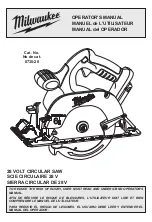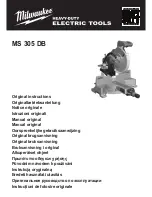
4
ENGLISH
◆
When disposing of batteries, follow the instructions given
in the section “Protecting the environment”.
◆
Under extreme conditions, battery leakage may occur.
When you notice liquid on the battery, proceed as follows:
- Carefully wipe the liquid off using a cloth. Avoid skin
contact.
- In case of skin or eye contact, follow the instructions
below.
Warning!
The battery fluid, a 25-30% solution of potassium
hydroxide, can be harmful. In case of skin contact, immediately
rinse with water. Neutralise with a mild acid such as lemon
juice or vinegar. In case of eye contact, rinse abundantly with
clean water for at least 10 minutes. Consult a physician.
Fire hazard! Avoid short-circuiting the contacts of a
detached battery (e.g. when storing the battery in a
toolbox).
Do not incinerate the battery.
Do not attempt to charge damaged batteries.
Chargers
◆
Use your Black & Decker charger only to charge batteries
of the type supplied with your tool. Other batteries could
burst, causing personal injury and damage.
◆
Never attempt to charge non-rechargeable batteries.
◆
Have defective cords replaced immediately.
◆
Do not expose to water.
◆
Do not open the charger.
◆
Do not probe the charger.
The charger is intended for indoor use only.
ELECTRICAL SAFETY
Your charger has been designed for a specific mains voltage.
Always check that the mains voltage corresponds to the
voltage on the rating plate.
Your charger is double insulated in accordance with
EN 60335; therefore no earth wire is required.
Warning!
Never attempt to replace the charger unit with a
regular mains plug.
Additional safety instructions for hand-held saws
◆
Always use the appropriate type of saw blade for the
workpiece material and type of cut.
◆
Only use saw blades in good condition.
◆
Always switch the tool off and wait for the saw blade to
come to a complete standstill before putting the tool down.
◆
Keep your hands well clear of the saw blade while working.
◆
Do not touch the saw blade immediately after the
operation as it might be hot.
◆
Do not attempt to saw extremely small workpieces.
◆
Before sawing in walls or floors, be aware of the location
of hidden pipes and wiring.
◆
Never switch on the tool when the saw blade is jammed
in the workpiece or when it is in contact with the material.
◆
Do not exert side pressure on the saw blade.
◆
Always hold the tool with both hands.
◆
Do not use the tool while in a tree, on a ladder or on any
other unstable surface.
◆
When cutting branches be aware of where the branch will
fall.
◆
Take special care when sawing woods and metal which
may produce toxic dust:
- Wear a dust mask specifically designed for protection
against toxic dust and fumes and ensure that persons
within or entering the work area are also protected.
- Do not let children or pregnant women enter the work area.
- Do not eat, drink or smoke in the work area.
- Dispose of dust particles and any other debris safely.
Overview (fig. A)
1. On/off switch
2. Lock-off button
3. Blade holder
4. Shoe
5. Blade clamp lever
6. Battery
7. Battery release button
8. Charger
9. Charger receptacle
Assembly
Fitting and removing the battery (fig. A)
◆
To fit the battery (6), line it up with the receptacle on the
tool. Slide the battery into the receptacle and push until
the battery snaps into place.
◆
To remove the battery, push the release button (7) while
at the same time pulling the battery out of the receptacle.
Fitting the saw blade (fig. B)
◆
Hold the saw blade securely. If the saw blade is fitted with
a tooth protector, leave it attached while fitting the blade.
◆
Pull the blade clamp lever (5) up to release the blade
clamping mechanism.
◆
Insert the shank of the saw blade into the blade holder (3)
as far as it will go.





































